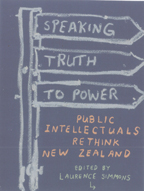 |
Speaking Truth to Power: Public Intellectuals Rethinking New Zealand. Edited by Laurence Simmons. Auckland, NZ: Auckland University Press, 2007.
An interesting collection of essays and interviews with leading intellectuals in New Zealand including Jane Kesley, Brian Easton, Nicky Hager, James Belich, Lloyd Geering, Marilyn Waring, and the late Michael King, who holds a laureate position. These strong and insightful opinions on this rather contentious subject leave the reader with a permeating sense of impotence, nostalgic at times, at the current state of the country’s public intellectual life. The introduction by the editor Laurence Simmons, an academic of strong Derridian and French structuralism, blames it on the resurgent individualistic, neoconservative agenda of the New Right, and the absence of a countering articulated left-liberal alternative. Simmons’ introduction traces the term intellectual and its historical uses, and settles down with Edward Said’s idea of the intellectual as one who lives a self-imposed exile, speaking from the margins of society, the “author of the language that tries to speak the truth to power.” Three core essays lead the way for the eleven interviews, with a revealing, short history of the New Zealand intellectual by Roger Horrocks and a set of shrewd word drawings by artist John Reynolds.
|